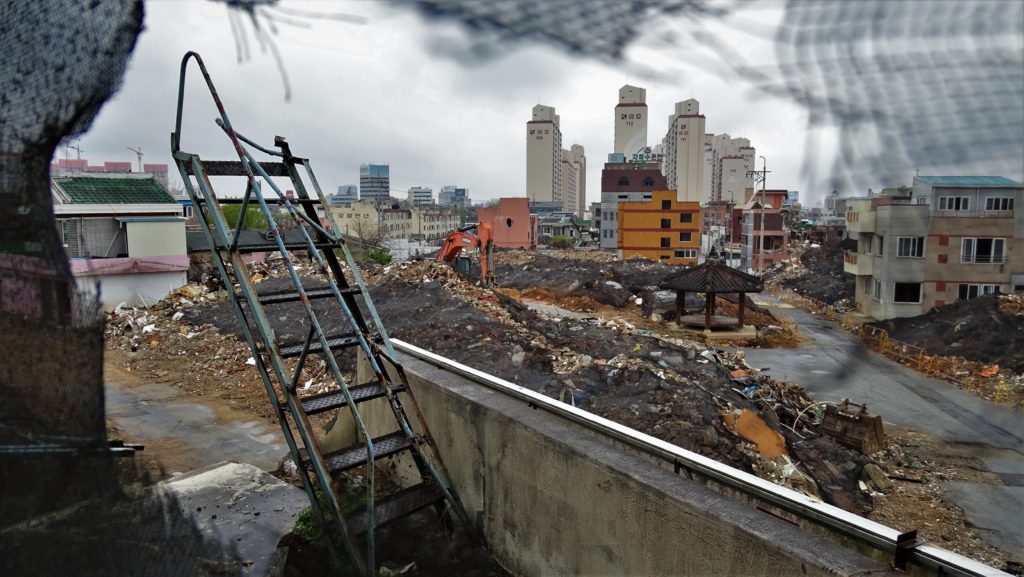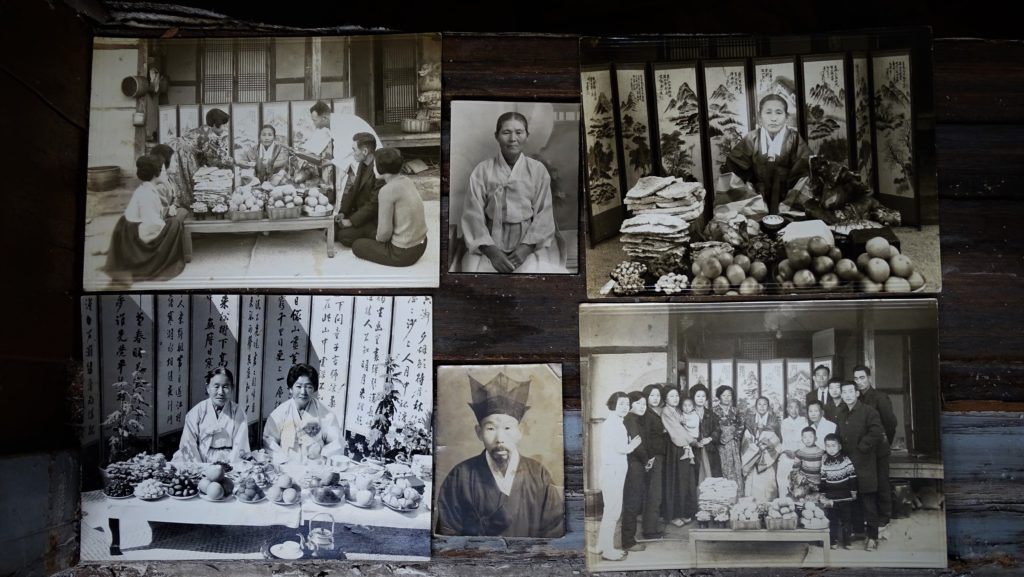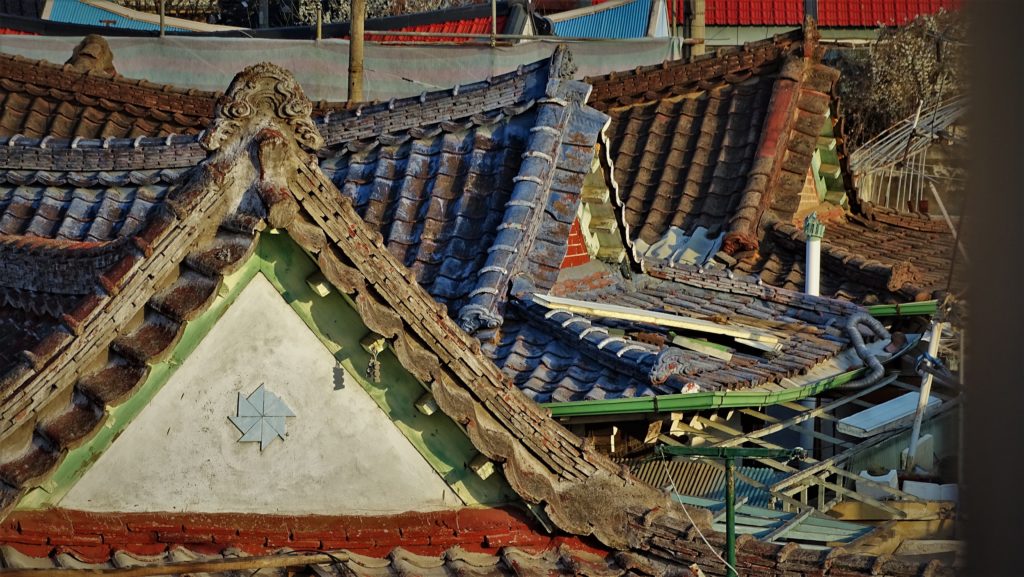The End of Flying Eaves
Written and photographed by Isaiah Winters
Korea’s traditional sweeping roofs have lost their place in modern society. Despite their beauty and functionality, today these roofs with intricately tiled rafters and long, flying eaves are relegated mainly to a dichotomy of dilapidated houses and renovated temples. (The traditional ondol (온돌) floor heating system, by contrast, has fared much better in modern times.) The temples will surely preserve this architectural tradition, but privately owned homes with this antiquated roof design are fast disappearing. Just over the last few months, Gwangju has slowly lost a large neighborhood in Gyerim-dong (계림동) with one of the highest concentrations of old-style sweeping roofs that I’m aware of. After spending a few weekends shooting the neighborhood, I became more and more curious about these old roofs and wanted to know why they were designed to “smile.”

When researching this question, I came across an argument put forward by Yoo Hyunjoon, a Harvard-educated professor of architecture at Hongik University.[1] To paraphrase Yoo, the protruding corner eaves (추녀, chunyeo) seen in traditional Korean architecture were highly functional, as they helped prevent mold and wet rot from weakening a structure’s wooden pillars (나무 기둥, namu gidung). This seems perfectly understandable; but why do they curve upward? Well, simply extending the corner eaves straight out to protect the corner pillars wasn’t a cure-all in itself, as that would block the sunlight needed to fully dry the pillars after a downpour. Therefore, Yoo contends, in order to best utilize the protection of the longer corner eaves while still allowing in the maximum amount of sunlight, the extended corner eaves were made to curve upward. Yoo further explained that the relatively conservative angle of Korean corner eaves is due to the peninsula’s northern latitude, where the summer monsoon brings less substantial rains than in regions of East and Southeast Asia closer to the equator. In places like Vietnam where there are heavier rains, the argument goes, traditional roofs were made to curve upward at more extreme angles to maximize the flying eaves’ effectiveness.
I’m in no position to say whether Yoo’s explanation is definitive, but it’s certainly better than some of the other theories I came across. One such theory was that in Buddhism, evil spirits only travel in straight lines and are thus repelled by the curvature of sweeping roofs. Naturally, that argument left me wanting. Another theory claimed that flying eaves were designed to allow in the maximum amount of sunlight in winter, when the sun is lowest in the sky, and provide the maximum amount of shade in summer, when the sun rises higher and lingers longer overhead. This seasonal sunlight theory wasn’t too bad, but something about it seemed half-baked nevertheless. An honorable mention goes to the armchair architectural historians who boiled their whole theory down to a single word: aesthetics.

Besides the purpose of flying eaves, another question that kept coming to mind while photographing this old neighborhood was why the traditional-style houses had knee-high porches out front with inadequate (or nonexistent) steps to help visitors up. Just imagine grandma hoisting herself up there every day! Of course, these porches were high because the houses were high, and the houses were high because their wooden support columns rested atop foundation stones (주춧돌, juchutdol), some of which were quite beautiful. Much like with flying eaves, it seems the raised foundation stones also helped protect the wood from – you guessed it – the spread of mold and wet rot. (For really old houses, that extra height also allowed enough space for the ondol system beneath.) As for why these old houses so often lack adequate steps up to the high porch, I suspect sheer masochism may be at play. I can’t imagine any other reason why an older person would endure such a daily struggle.
Apart from these questions, I guess the only remaining mystery is why so many of Gyerim-dong’s old hanok (한옥) homes had to be destroyed in the first place. The answer, of course, is to make way for new apartments. The development site sits directly across the street from Gwangju National University of Education, and when all is said and done, the complex will be located right along the city’s new subway line, so there’s a lot of money to be made in developing the land for future buyers and investors. Though the project’s construction phase likely won’t start for a few more months, the plan is for Hyundai I-Park and SK View Consortium to build some 15 apartment blocks standing 26 stories tall with well over 1,000 housing units in total.

As of this writing, only the outer ring of the neighborhood is still intact behind walls of scaffolding and construction tarp. The demolition company has cleverly kept the perimeter buildings up as a defensive barrier and then blocked off the spaces between them with tarp while slowly chomping up the center house by house, block by block. This strategy has helped keep both potential looters out and any potential loot in. The weakest points in the barriers are in areas where adamant residents have not yet left, and this is where terminally curious people like me usually get in. I’ll likely visit the area once or twice more to see what features of the old neighborhood the demolition crew keeps, like the old pavilion in the center, which stands alone amid the rubble. It may end up being the sole reminder of a neighborhood that was once filled with flying eaves.
Reference
[1] Lee, G. (2017, October 28). 한옥의 지붕이 곡선인 진짜 이유. Retrieved from the JoongAng Ilbo website: https://news.joins.com/article/22058898
The Author
Originally from Southern California, Isaiah is a Gwangju-based urban explorer who enjoys writing about the City of Light’s lesser-known quarters. When he’s not roaming the streets and writing about his experiences, he’s usually working or fulfilling his duties as the Gwangju News’ heavily caffeinated chief proofreader.





